Introduction
User Acceptance Testing (UAT) plays a pivotal role in software development, ensuring that applications align with end-user requirements and expectations. Unlike other forms of testing, UAT actively involves end-users or stakeholders to assess the software's real-world usability. It goes beyond identifying bugs and technical issues and focuses on affirming that the software delivers on its promises and facilitates users' tasks.
The significance of UAT is increasingly recognized as a strategic tool that enhances customer satisfaction, reduces post-release issues, and contributes to overall ROI. In this fast-paced world of software innovation, UAT serves as the final checkpoint before product release, ensuring the quality and reliability of software that empowers our interconnected world.
Understanding User Acceptance Testing
User Acceptance Testing (UAT), also referred to as end-user testing, stands as a pivotal phase in the software development life cycle, serving as the definitive test to ensure software applications align with the specific requirements and expectations of the end user. Unlike other forms of testing that may focus on technical correctness, performance, or compliance with design specifications, UAT uniquely engages the actual end-users or stakeholders to assess whether the software is capable of carrying out the tasks it's intended for in real-world scenarios.
UAT is not merely about identifying bugs or technical issues; it's about affirming that the software delivers on its promises and facilitates the tasks users need to perform. This requires a deep understanding of the business domain and the users' day-to-day workflows. For instance, a well-crafted UAT process will involve real-world scenarios that reflect the users' actual work conditions, ensuring the software is not just theoretically sound but practically useful.
The significance of UAT is underscored by the shift in perception from seeing it merely as a cost center towards recognizing its immense contribution to the overall ROI. By incorporating the feedback from UAT into the development process, software teams can make informed decisions that enhance the functionality and usability of the product, leading to savings in time and resources while avoiding the costly repercussions of releasing inadequate software.
In the fast-paced world of software innovation, the role of UAT has never been more crucial. It serves as the final checkpoint before the product's release, ensuring that the accelerating speed of development does not compromise the quality and reliability essential to software that empowers our interconnected world.
The Significance of User Acceptance Testing
User Acceptance Testing (UAT) is a crucial phase in the software development life cycle, serving as the final checkpoint before a product release. This process involves real-world testing by end-users or clients to ensure the software meets their requirements and performs as expected in their environment. The significance of UAT lies in its ability to identify mismatches between user expectations and the actual functionalities, guiding developers to make the necessary adjustments for a polished end-product.
Spotify's introduction of video podcasts, which has seen a surge in user engagement, underscores the importance of aligning product offerings with user demand. The transition from audio-only to video formats demonstrates how user feedback can drive innovation and maintain market leadership.
Similarly, when California State University's Identity, Access Management and Security team observed a threefold increase in productivity metrics following training, it highlighted the value of equipping teams with the knowledge to efficiently execute UAT. Users updated their collections 31 times more often, evidencing the dynamic nature of software requirements and the need for iterative testing.
Moreover, Matsmart-Motatos' experience with A/B testing tools reflects the need for streamlined testing processes in e-commerce. With technology being central to their business, the adoption of advanced analytics tools facilitated their growth and reinforced the importance of rigorous UAT practices.
The landscape of technology is swiftly evolving, with software becoming deeply engrained in our daily lives. The complexity and fast-paced development of software systems have made software testing, especially UAT, an indispensable process. It not only identifies bugs and defects, saving time and resources, but also validates the software against the intricate tapestry of user requirements, ensuring a superior product.
In conclusion, UAT is not a mere step in the QA process; it is a strategic tool that enhances customer satisfaction, reduces post-release issues, and ultimately contributes to the product's success. The examples of Spotify, California State University, and Matsmart-Motatos illustrate the transformative impact of effective UAT in delivering software that excels in both performance and user satisfaction.
Purpose of User Acceptance Testing
User Acceptance Testing (UAT) is more than just a routine step in the software development lifecycle; it is a critical validation process that ensures the delivered software system can handle real-world tasks and fulfill the precise needs of its users. During UAT, the actual software consumers or those who commissioned its creation participate actively. Their role is pivotal—they verify that the product not only meets the technical specifications but also aligns with their business requirements and can perform effectively in a live environment.
The significance of UAT lies in its position as the final verification phase before a product goes live. It's not just about identifying bugs—though that is certainly a key aspect—it's about making sure that the software is intuitive, user-friendly, and robust enough to handle the tasks it was designed for. In essence, UAT is the bridge between the technical completion of software and its real-world deployment, ensuring that all the features work harmoniously to support the user’s daily operations.
UAT is crucial in today's fast-paced digital environment, where the introduction of new technologies like generative AI is reshaping user expectations, especially in sectors like e-commerce. Users are looking for software that not only functions seamlessly but also integrates innovative features to make their lives easier. Aligning with this trend, projects like AutSPACEs have embraced the notion of 'Nothing about us, without us,' involving users from the earliest stages to shape a product that truly resonates with their needs.
This user-centric approach to testing is supported by experts like Tanja Vos, who emphasizes the importance of engaging end-users in the testing process for a product that not only works but works well for its intended audience. With the growing complexity of software and the criticality of digital media across devices, techniques like Omnichannel and Multichannel testing have become more relevant, ensuring that applications deliver consistent and reliable user experiences across all platforms.
In conclusion, UAT is not merely a checkbox to tick off but a comprehensive process that guarantees software readiness for the real world, directly contributing to product success and customer satisfaction. By focusing on the end-user's perspective, businesses can deliver software that not only meets but exceeds user expectations, ensuring longevity and relevance in an ever-evolving digital landscape.
Steps to Perform User Acceptance Testing
User Acceptance Testing (UAT) serves as the critical bridge between the final stages of development and the live production environment, where the software is set to perform its intended tasks. To ensure a successful transition, the UAT phase must be executed with precision and attention to user requirements. Here's a breakdown of what this involves:
-
Planning and Preparation: A clear scope definition is crucial to set the boundaries for UAT. Careful selection of testing tools, which are both budget-friendly and meet technical requirements, is vital. Additionally, setting up a robust framework supports the automation of test processes.
-
Test Case and Data Preparation: Creating realistic test scenarios is essential. This includes configuring the environment to reflect production conditions and managing test data to mimic real-world usage, thus ensuring the software's functionality aligns with user expectations.
-
Executing Tests and Monitoring Results: Running the tests is more than a mere formality; it involves a meticulous process of tracking outcomes, identifying issues, and understanding their impact on user experience.
-
Validating Business Objectives: This stage is not just about ticking off requirements; it's a rigorous assessment to confirm that the software delivers on its promised capabilities and enhances user productivity, as evidenced by significant metrics improvements post-testing.
-
Feedback Loop: Documenting issues and feedback is a collaborative effort that fosters continuous improvement, ensuring that the software evolves in response to user needs.
-
User Sign-off: The final step is obtaining user approval, which is not merely a formality but a testimony to the software's ability to meet user requirements and perform reliably in the real world.
Throughout these steps, it's important to remember the mantra: 'The more your tests resemble the way your software is used, the more confidence they can give you.' This user-centric approach to testing is essential for delivering software that not only functions but also thrives in the dynamic and demanding environment of e-commerce and beyond.
Developing a UAT Plan
Crafting a robust User Acceptance Testing (UAT) strategy is a pivotal step in software development, ensuring the final product aligns with both business objectives and end-user expectations. A meticulous UAT plan is the blueprint for a successful validation process, encompassing critical elements such as:
- Clearly defined UAT goals that mirror business needs
- Detailed test scenarios and cases to examine each application aspect
- Specific test data requirements for accurate assessment
- A prepped testing environment that mirrors real-world conditions
- Assigned roles and responsibilities, ensuring team accountability
- A structured UAT timeline that aligns with project milestones
- Transparent communication channels for feedback and issue resolution
By integrating these components, the UAT plan transforms into an organized and targeted approach, leading to an efficient and comprehensive assessment of the software. With the rapid evolution of technology, as reflected in the enthusiasm for generative AI in e-commerce, the importance of an adaptable and thorough UAT framework cannot be overstated. It's not just about bug tracking; it's about delivering a seamless, functional experience that stands up to the dynamic demands of users and thrives in a competitive digital marketplace.
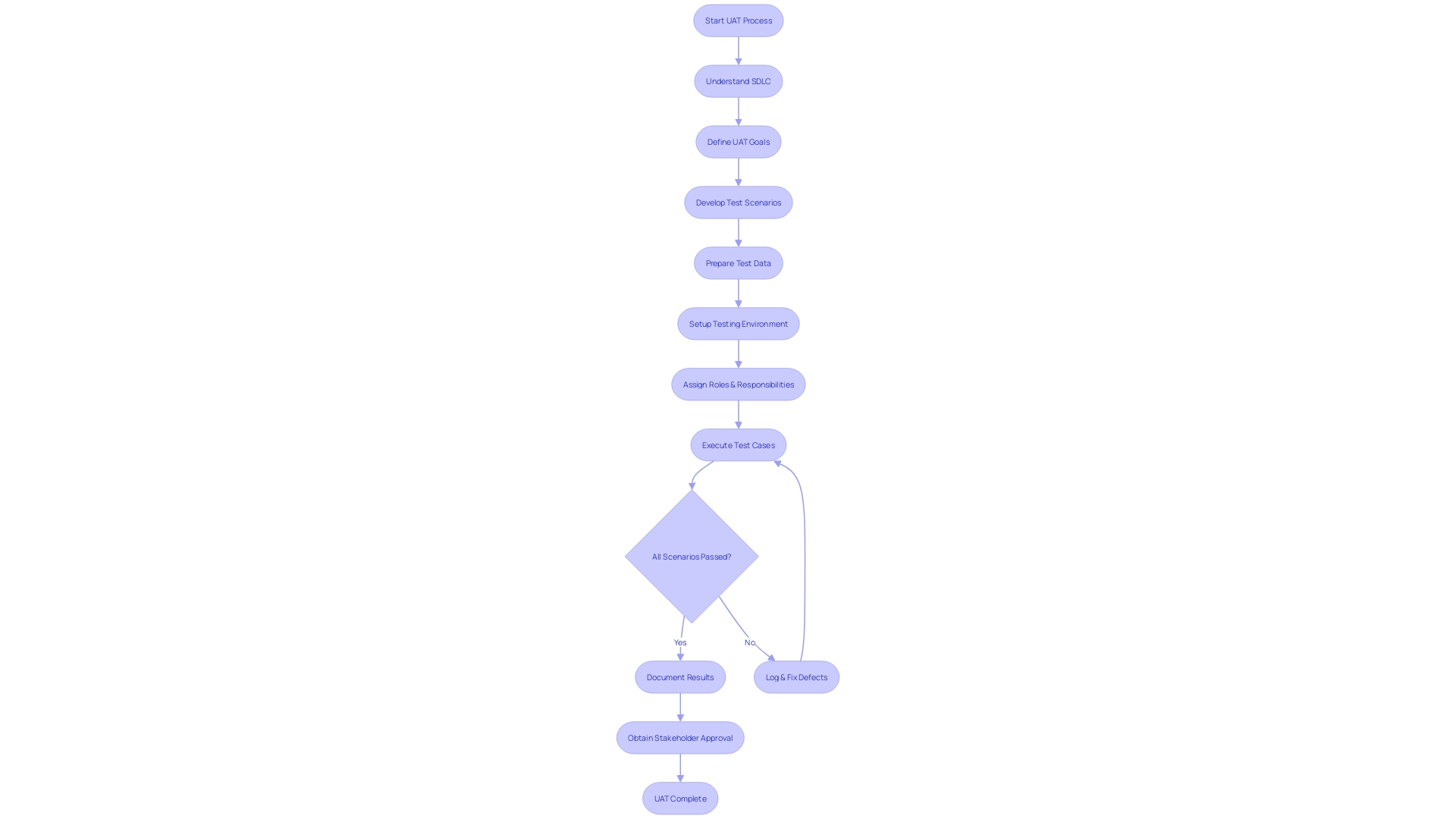
Identifying Test Scenarios and Test Cases
Crafting precise test cases is the cornerstone of User Acceptance Testing (UAT), playing a pivotal role in capturing the system's requirements. These cases serve as detailed blueprints that guide testers through the validation of software applications, ensuring each feature operates correctly and meets user expectations. A test case must be comprehensive, encompassing a unique identifier, a description of its purpose, prerequisites for its execution, and a step-by-step breakdown of actions to be performed.
Effective test cases reflect real-world scenarios, incorporating various user roles and potential workflows, and meticulously examining edge cases to guarantee extensive coverage. This meticulous approach to defining test scenarios and cases is akin to both art and science, much like training machine learning models, where bias must be carefully avoided to ensure the integrity of results.
The objective of UAT is to align software performance with business needs, requiring end-users with domain expertise to carry out this validation. By focusing on critical user interactions and desired functionalities, UAT can provide a reliable measure of software readiness before its release, akin to the rigorous evaluation of machine learning models against specific metrics such as accuracy and precision. Incorporating well-crafted test cases into the testing process is essential to not only validate functionality but also to build confidence in the software's performance and its ability to meet user and business requirements.
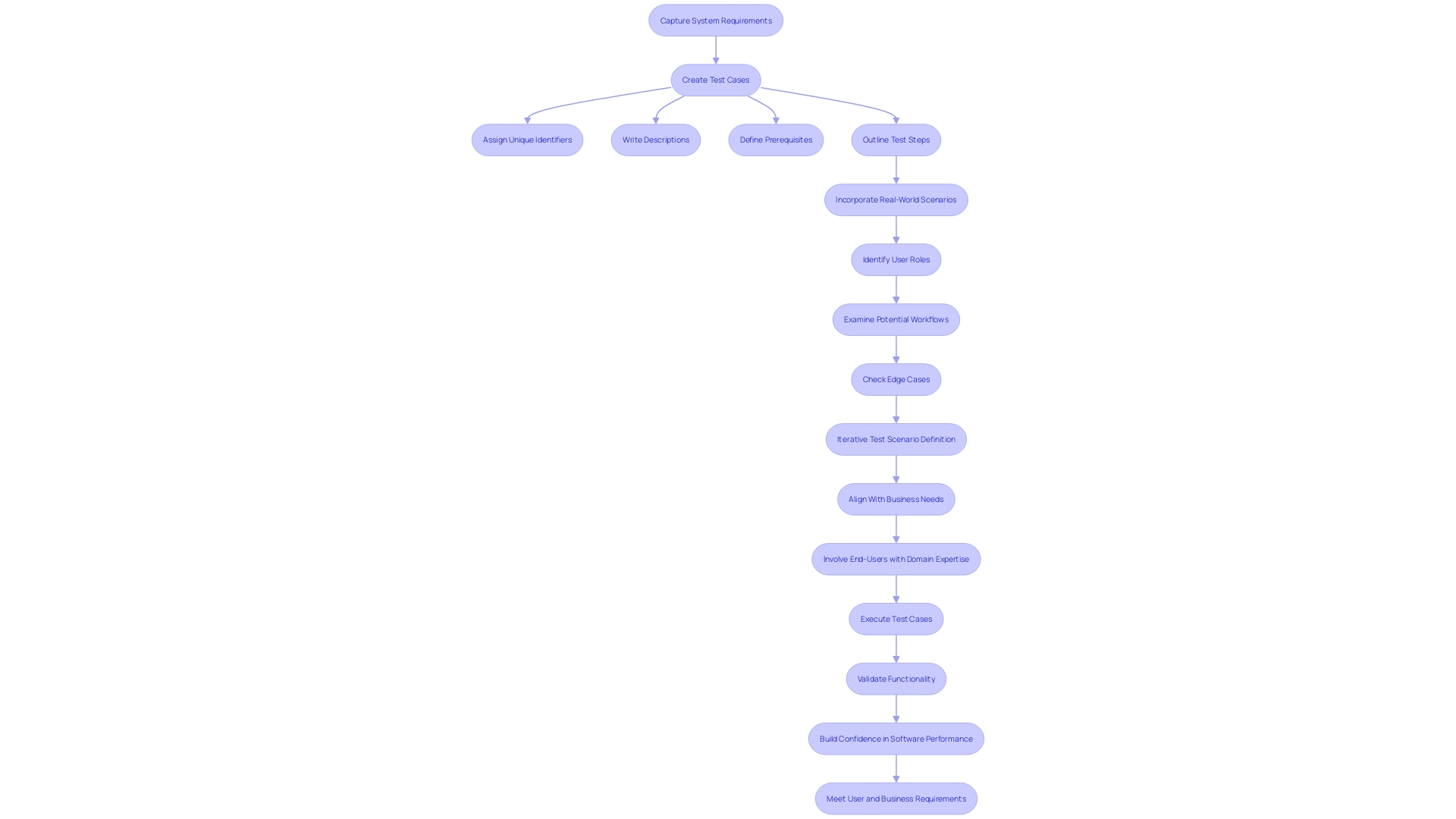
Preparing Test Data
Creating comprehensive test data is pivotal to simulate real-world user engagement with software. This involves crafting intricate scenarios that reflect the diverse ways users may interact with the application. To mirror the unpredictability of user behavior, test data should encompass a breadth of conditions, from typical usage patterns to edge cases.
For instance, in examining software bug reports, it becomes evident that unexpected behaviors—malfunctions, security flaws, and performance hitches—often arise under unique circumstances that only rigorous testing can uncover.
In the realm of software testing, meticulous scrutiny is not only beneficial but necessary. Every aspect of the application must undergo evaluation, as the slightest deviation between expected and actual outcomes could indicate underlying issues. This is exemplified by expert witnesses in software-related court cases who leverage their critical thinking and deep understanding of software quality to dissect and analyze code for potential flaws.
Moreover, contemporary approaches like machine learning (ML) have also been applied to software testing, offering predictive insights and automating certain aspects of the process. Utilizing ML, testers can assess software with metrics like accuracy and precision, which hinge on the quality of training and testing data. It's a reminder of the importance of well-constructed test data, which not only feeds into traditional testing paradigms but also into advanced, data-driven methodologies.
Ultimately, the goal of this rigorous testing is to ensure the software functions seamlessly and upholds the high standards required for today's digital solutions. By doing so, developers and testers can preemptively tackle potential setbacks, saving time and resources while delivering a product that meets, or exceeds, user expectations.
Running the Tests and Tracking Results
User Acceptance Testing (UAT) is a pivotal phase in the software development life cycle, ensuring that new systems fulfill the user's requirements and work as anticipated in real-world scenarios. Here, the identified test scenarios and cases are meticulously executed and their outcomes systematically recorded. This thorough documentation of results, which includes any defects or issues that surface during testing, is crucial for guiding the development team to areas that demand refinement.
To grasp the significance of detailed test cases, consider the Applicant Tracking System (ATS) developed by Workable. ATS, which empowers hiring teams worldwide, grew in complexity as parts of its code were sectioned off into other services. Markos Fragkakis, Staff Engineer at Workable, outlines the journey of their CI process and its evolution, emphasizing the importance of strategic decision-making and diligent documentation during the implementation phase.
Reflecting on the importance of test cases, a set of conditions or variables guides testers to verify if a software application operates correctly. This set includes inputs, execution conditions, and the expected outcomes, which altogether form a structured pathway to affirm that each feature behaves as intended. A typical test case encompasses a unique identifier, a concise test description, prerequisites, and explicit test steps.
The essence of UAT lies in its focus on the end-user's perspective, ensuring the software aligns with business needs and expectations. The end-user, equipped with business knowledge, undertakes this validation to affirm the application's readiness for deployment.
In the broader context of HCI research, rating scales are instrumental in assessing user experience, usability, and similar factors. These scales yield insights into user-computer interactions, aiding in the refinement of technological interfaces. Techniques range from attitudinal research methods to field studies, like contextual inquiries, which delve into users' natural interactions with systems to garner a deep understanding of user behaviors and practices.
Thus, the role of UAT, reinforced by well-constructed test cases, is not just a checkpoint but a comprehensive approach to ensuring software excellence and user satisfaction.
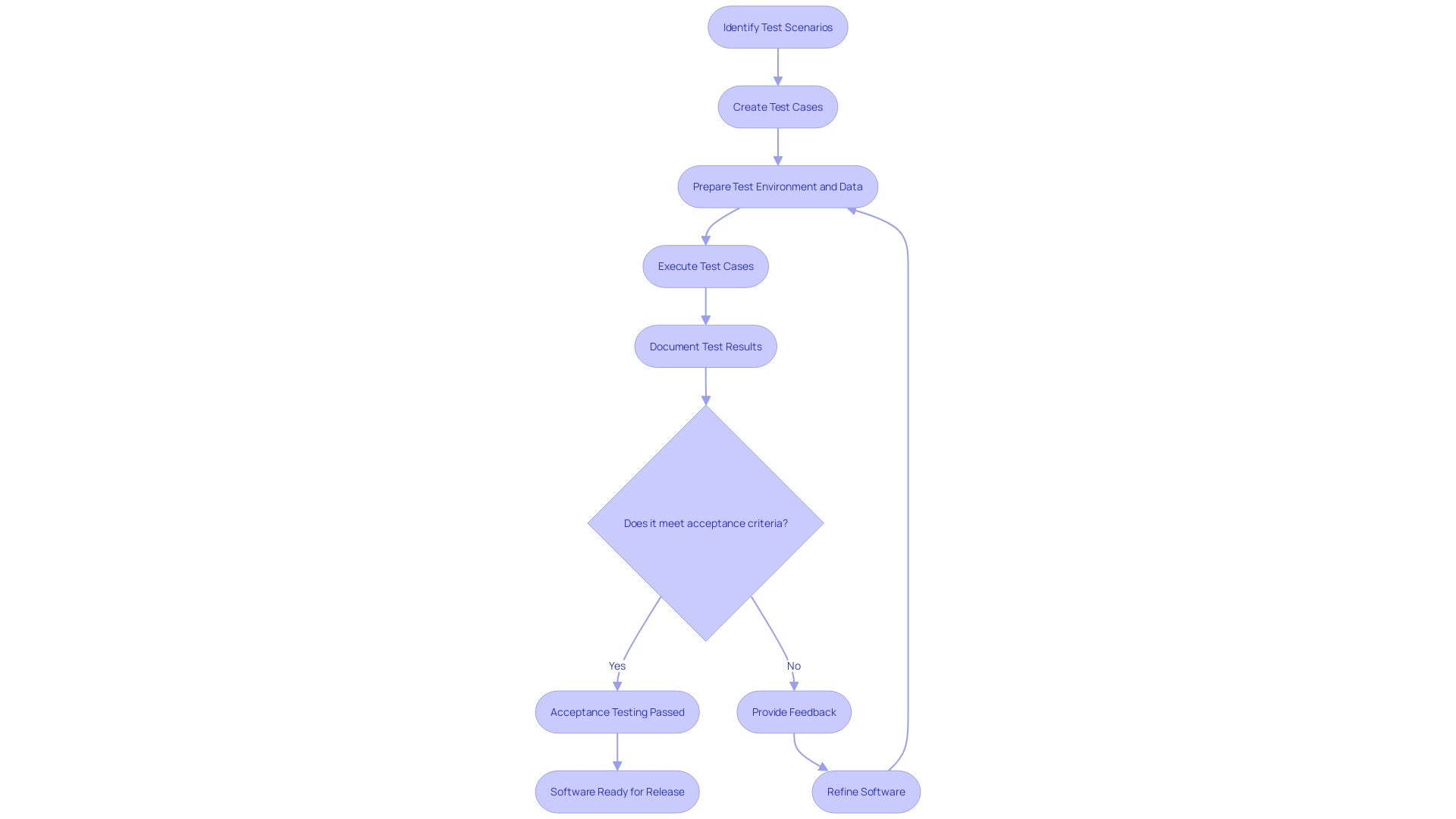
Confirming Business Objectives Are Met
User Acceptance Testing (UAT) serves as the final verification phase to ensure that software systems meet business demands and provide the expected value. It's a crucial step where actual software users test the application to validate that it can handle required tasks in real-world scenarios, mirroring the operational environment. UAT is not just about identifying bugs—it's about confirming that the software is equipped to deliver a seamless and efficient user experience that aligns with the users' needs and expectations.
For instance, Nets, a prominent digital payment solutions company, tackled the challenge of presenting technical data in a user-friendly manner. Their innovative approach to onboarding new employees led to improved engagement, demonstrating the importance of a software's usability and functionality in real-world applications. This aligns with the broader industry perspective, which increasingly recognizes software testing not as a cost burden but as a strategic investment capable of yielding significant ROI through enhanced quality and user satisfaction.
Moreover, documenting critical use cases, as emphasized by the OMG UML specification, is vital for understanding the system's intended use and setting the stage for successful UAT. Quality criteria—such as capability, reliability, and usability—are essential to consider, as they frame users' requirements and influence the overall perception of the software. Understanding these criteria through methods like contextual inquiry and attitudinal research can offer insights into user behavior and expectations, ultimately guiding the development of a product that resonates well with its audience.
In today's fast-paced innovation climate, quality assurance teams must balance the velocity of software releases with the necessity for robust, user-centered testing. By integrating modern methodologies and maintaining a focus on user experience, organizations can ensure that their software not only functions correctly but also thrives in the competitive digital landscape.
Best Practices for User Acceptance Testing
User Acceptance Testing (UAT) stands as the final validation step in the Software Development Life Cycle (SDLC), ensuring that the software delivers on its promise to meet business requirements and handle real-world tasks. To enhance the efficacy of UAT, one must engage with actual and potential users early on, as their feedback is instrumental in refining the product and identifying any discrepancies.
Creating a detailed UAT checklist and an encompassing test plan can serve as a roadmap for the process, outlining the testing scope and objectives, while also establishing a schedule for test execution. Furthermore, developing precise test cases is vital, as they provide the necessary conditions and expected results to guide testers in their verification efforts.
A collaborative approach with the development team is essential, and employing realistic test scenarios with accurate data will enhance the relevancy of the UAT. Clear communication channels are crucial for providing actionable feedback that can lead to impactful product improvements.
Finally, documenting the test outcomes and any issues encountered provides a transparent record that supports obtaining user sign-off, a critical milestone before the software's release. By adhering to these best practices, UAT can effectively validate that the software meets the end-user's expectations and is apt for its intended use.
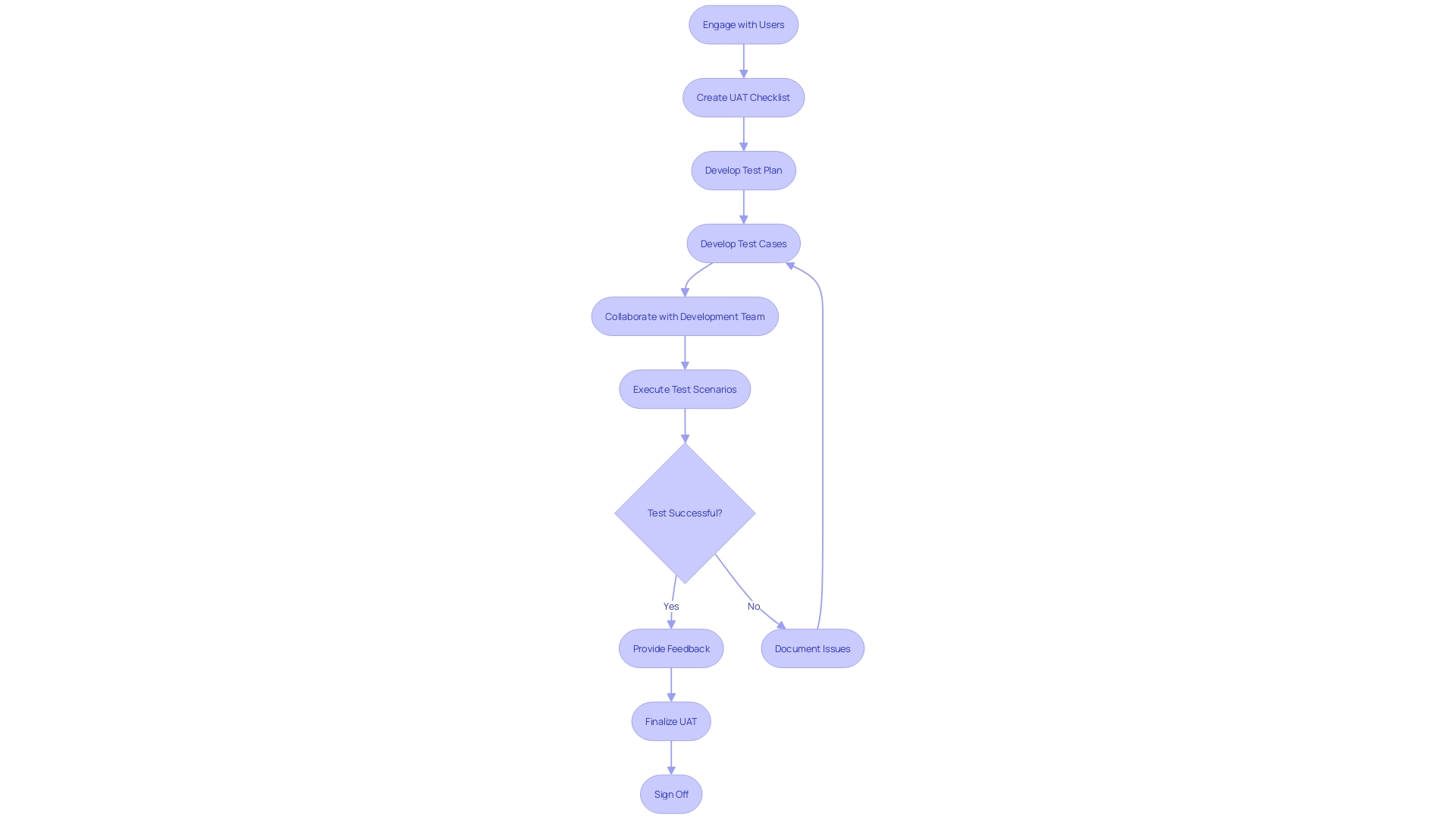
Common Mistakes to Avoid During UAT
User Acceptance Testing (UAT) stands as the last line of defense before a software product meets its audience. This critical phase aims to validate the product against real-world business needs and requirements. However, the efficacy of UAT hinges on avoiding key pitfalls that can compromise the outcome.
- Clearly defined objectives are the compass for UAT; without them, the testing lacks direction.
- End-user involvement is indispensable. Their hands-on experience and insight can illuminate issues that would otherwise go unnoticed.
- Comprehensive test scenario coverage ensures that the software is examined from all angles, leaving no stone unturned.
- Proper documentation is not just a formality; it's a vital repository of knowledge for current and future reference.
- Timely feedback loops enable quick rectifications and course corrections, enhancing the product's quality.
- Regression testing is not a corner to be cut. It's essential to confirm that new features haven't disrupted existing functionalities.
- Finally, user suggestions and feedback are valuable currencies. Ignoring them is akin to turning away insights that could propel the product to excellence.
By steering clear of these common mistakes, the UAT phase can be a smooth sail towards a successful product launch.
Common Challenges of User Acceptance Testing
User Acceptance Testing (UAT) is the final, critical phase in the software development cycle, designed to ensure that the application not only meets its technical specifications but also fulfills the real-world needs and expectations of its users. During UAT, actual software users test the system to validate that it can successfully perform required tasks in real-world scenarios.
Challenges are inherent in this phase, such as the limited availability of end-users, who are essential for providing authentic feedback. Moreover, business requirements can often be complex or subject to change, which may lead to complications during testing. Setting up an adequate test environment poses its own set of difficulties, as does maintaining clear lines of communication throughout the testing team.
Reproducing specific user scenarios to test the software's functionality can be problematic, and all these tasks need to be completed within the limited timeframe of the UAT phase.
However, by understanding these challenges, teams can strategize to overcome them. For instance, exploratory testing allows testers to simulate the behavior and choices of end-users, enhancing the software's readiness for real-world use by uncovering bugs, improving test coverage, and identifying usability issues that might not surface through structured testing methods.
Furthermore, keeping abreast of trends and adapting to advancements in testing tools and technologies are crucial. As the World Quality Report suggests, focusing on automation and a shift-left approach can help streamline the QA process, leading to shorter development cycles and higher quality outcomes. In the current age of digital acceleration, leveraging robust QA automation is crucial for maintaining the pace of innovation while ensuring software quality.
Ultimately, by proactively anticipating these common challenges and employing a combination of traditional and exploratory testing strategies, teams can enhance the effectiveness of the UAT phase, thereby delivering software that not only functions seamlessly but also excels in meeting user expectations.
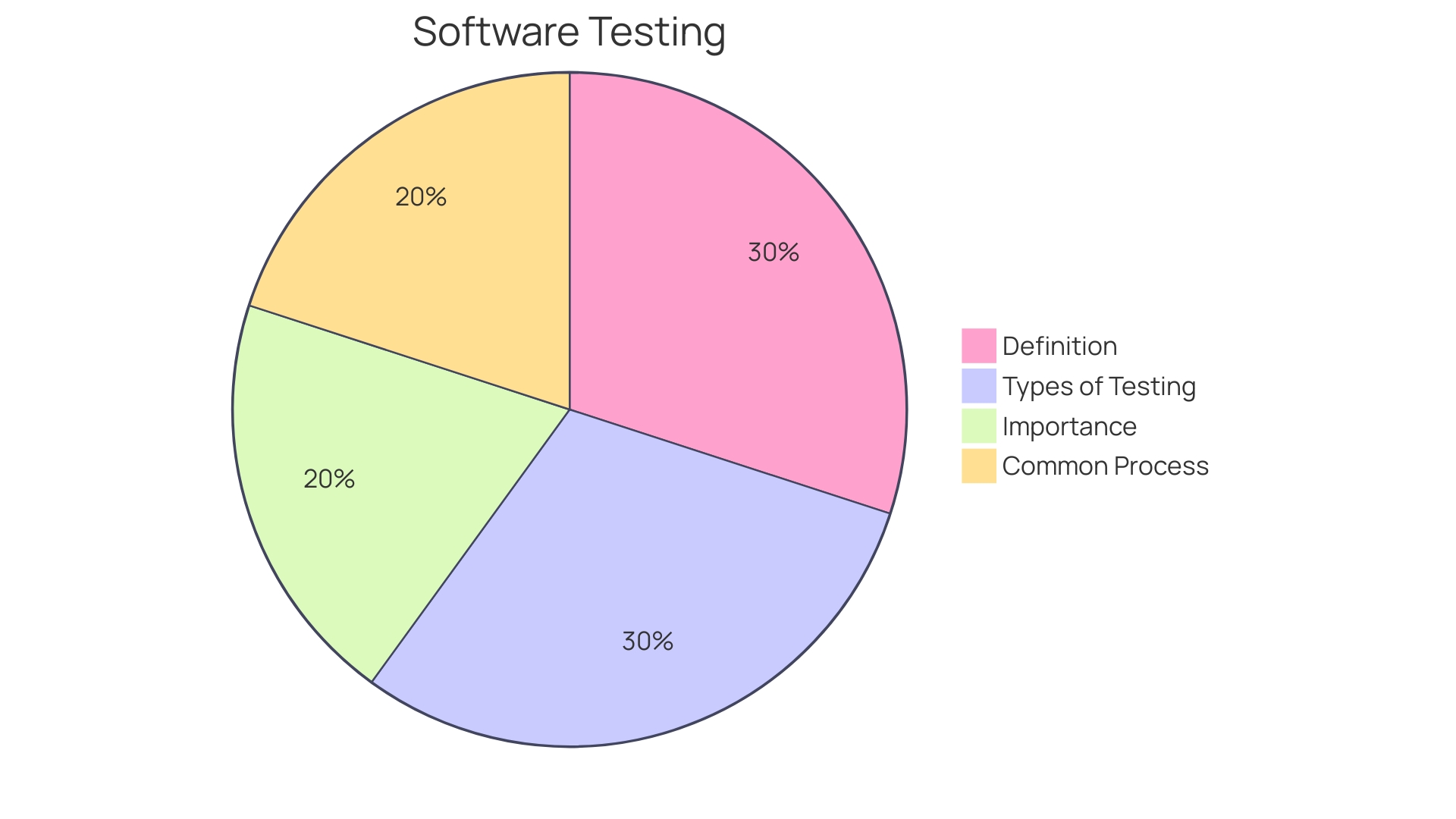
Tools for Conducting User Acceptance Testing
In the realm of software development, User Acceptance Testing (UAT) serves as a critical phase that hinges on the participation of clients or end-users. It is at this juncture that the product is scrutinized against real business needs and performance expectations, ensuring it can competently meet its users' tasks in the real world.
UAT is not just about testing; it's about validating the software's alignment with the business objectives and user requirements. This validation is typically undertaken by an end-user who has a solid grasp of the business context, and it represents the culmination of the Software Development Life Cycle (SDLC).
To streamline this essential process, several tools have arisen as frontrunners, enhancing collaboration and efficiency. TestRail, JIRA, and Zephyr stand out for their robust test case management and defect tracking capabilities, while Trello and Microsoft Excel offer simpler, yet effective, means to organize and monitor testing efforts.
As we navigate the tools shaping software testing's efficiency, it's clear that the choice of tool should align with specific project needs—whether it's for crafting narratives, distilling information, or managing complex datasets. The evolution of testing tools has been profound, and as noted in industry discussions, the relationships and behaviors within IT teams are directly influenced by these tools. The trust factor plays a significant role, and there's a recognized need for tools that foster positive collaboration and not inadvertently introduce distrust.
The landscape of testing has seen a shift towards more industrialization and automation, particularly in the wake of economic pressures. This shift has been documented in reports over the years, highlighting a consistent drive towards improving quality and testing practices, aiming for faster and higher quality life cycles.
Ultimately, the adoption of these tools is not just about facilitating UAT but also about embracing a mindset that anticipates and investigates potential issues before they reach the end-users, thereby safeguarding against unexpected 'trouble' that could compromise the product's success.
Importance of Feedback and Documentation in UAT
User Acceptance Testing (UAT) serves as the final validation step in the Software Development Life Cycle (SDLC), where clients or end-users engage with the software to ensure it aligns with their business needs and performs as required. Constructive feedback during this phase is invaluable, as it reflects the end-users' perspective, allowing the development team to fine-tune the application for optimal real-world performance.
Documenting the UAT process, including any issues encountered, test results, and suggestions for improvement, is indispensable. It creates a transparent record for all parties involved, from developers to stakeholders, ensuring that everyone is on the same page regarding the software's capabilities and any areas that require attention.
A noteworthy point raised by Frank Dahle during an InfoQ interview underscores the importance of clarity in expectations and responsibilities. As companies face the challenge of creating accessible software systems, it becomes imperative that all user requirements, including accessibility, are comprehensively outlined in contracts before signing. This attention to detail in the UAT phase can prevent future disputes and ensure that the software meets all necessary standards.
In practice, UAT is more than just a testing phase—it's a critical opportunity for end-users to confirm that the software can effectively handle the tasks it's intended for. Leveraging methodologies such as questionnaires and contextual inquiries can provide deeper insights into user interaction, further guiding developers towards delivering a product that not only meets but exceeds user expectations.
By integrating user feedback and thorough documentation into UAT, businesses can achieve a level of assurance that their software not only functions technically but also delivers a user experience that resonates with their clientele's real-world applications.
Conclusion
In conclusion, User Acceptance Testing (UAT) is a crucial phase in software development, ensuring that applications align with end-user requirements and expectations. UAT goes beyond identifying bugs and technical issues, focusing on affirming that the software delivers on its promises and facilitates users' tasks. It serves as the final checkpoint before product release, ensuring the quality and reliability of software that empowers our interconnected world.
The significance of UAT is increasingly recognized as a strategic tool that enhances customer satisfaction, reduces post-release issues, and contributes to overall ROI. By incorporating feedback from UAT into the development process, software teams can make informed decisions that enhance the functionality and usability of the product, leading to savings in time and resources.
To perform UAT effectively, it is important to follow a structured process that includes planning and preparation, test case and data preparation, executing tests and monitoring results, validating business objectives, maintaining a feedback loop, and obtaining user sign-off.
Crafting a robust UAT plan is essential for successful software development. This plan should include clearly defined goals, detailed test scenarios and cases, specific test data requirements, a prepped testing environment, assigned roles and responsibilities, a structured timeline, and transparent communication channels.
Creating precise test cases is crucial in UAT, as they serve as detailed blueprints that guide testers through the validation process. Test cases should reflect real-world scenarios, incorporating various user roles and potential workflows.
Running the tests and tracking the results is a crucial part of UAT. This phase involves executing identified test scenarios and cases and systematically recording the outcomes. Detailed documentation of results, including any defects or issues, guides the development team in refining the software and improving its quality.
Confirming that business objectives are met is a key aspect of UAT. By validating that the software meets real-world business needs and provides the expected value, organizations can ensure that the software aligns with user expectations and performs reliably in the real world.
To perform UAT effectively, it is important to follow best practices such as engaging with actual and potential users, creating a detailed UAT checklist and test plan, developing precise test cases, employing realistic test scenarios, maintaining clear communication channels, and documenting test outcomes.
Avoiding common mistakes during UAT is crucial for successful software development. Mistakes to avoid include lacking clearly defined objectives, insufficient end-user involvement, inadequate test scenario coverage, inadequate documentation, neglecting regression testing, and disregarding user suggestions and feedback.
In summary, UAT is a critical phase that ensures software aligns with end-user requirements and expectations. By following a structured process, creating a robust UAT plan, developing precise test cases, running tests and tracking results, confirming business objectives, and adhering to best practices, software teams can validate the software's readiness for real-world deployment and deliver a product that meets user expectations.





